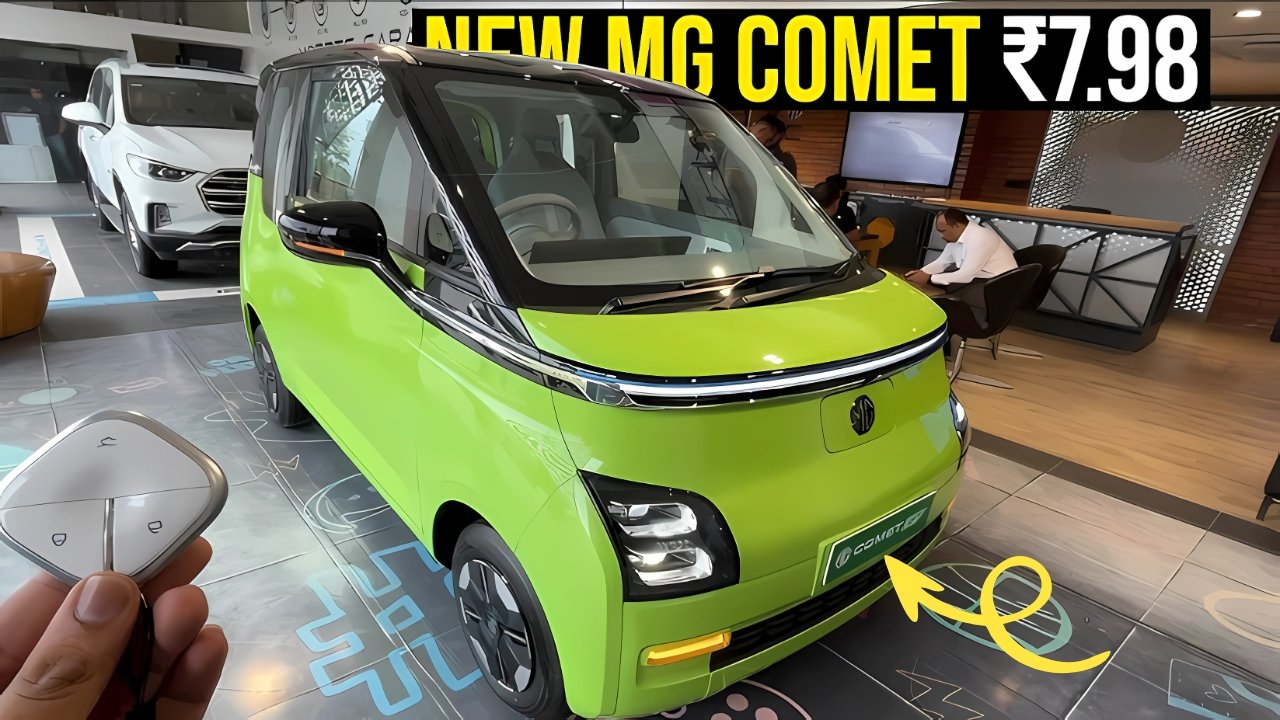MG Comet EV: Nobody gave it much thought when MG announced a micro-EV for India. We’d seen this movie before – foreign brands bringing half-baked concepts that never quite connect with the market. Then the Comet EV actually showed up last April, looking like something from a sci-fi cartoon. My neighbor bought one of the first ones – lime green with those weird black panels. The sales guy probably couldn’t stop grinning, knowing he was selling something that would turn heads everywhere it went. That first batch sold out weirdly fast, and suddenly these little boxes started appearing all over Mumbai. The “Comet” name wasn’t just random – it hit the market with unexpected impact and left everyone talking.
The Battery Situation: Surprisingly Not Terrible
Let’s be brutally honest about that battery – 17.3kWh sounds pathetically small on paper. You’d expect maybe 100km range, tops. But somehow, this tiny pack delivers about 230km in actual city driving. My cousin’s six-month-old Comet shows minimal degradation after daily commuting. The real magic happens in stop-and-go traffic, where it sips electrons like they’re rationed. The tiny footprint and light weight (under 800kg) mean it needs less juice to move. Recharging takes roughly 7 hours on a standard home outlet – annoying if you’re in a hurry, but perfect for overnight charging. No fancy charging infrastructure needed – just plug it into the same socket as your refrigerator. It’s not groundbreaking tech, but it’s perfectly matched to its purpose.
The Driving Experience: Weirdly Addictive
Forget everything you think you know about budget cars. This thing has genuine personality. The 42hp motor with 110Nm of instant torque makes this matchbox surprisingly zippy through city traffic. My colleague’s white Comet regularly embarrasses much more expensive cars when the light turns green. The turning radius is almost comical – you can practically spin it on a dinner plate. Parking becomes a non-issue – spaces you’d normally drive past become valid options. The throttle response has this eager puppyish quality that makes mundane commutes weirdly enjoyable. It’s not fast by any objective standard, but in the urban jungle, its agility creates a different kind of fun.

The Interior: Tardis-Like Space Magic
The exterior dimensions suggest you’d need to be a contortionist to fit inside, but somehow the interior feels genuinely spacious for two adults. My 6’2″ brother-in-law fits comfortably in the driver’s seat without his knees hitting the dashboard. The minimalist approach works here – two screens dominate the dash, with physical controls limited to the essentials. The seating position is more upright than conventional cars, creating extra legroom. The rear seats exist mostly in theory – they’re suitable for small children or emergency use only. But fold them down, and suddenly you’ve got enough cargo space for a major grocery run or airport luggage. It’s not luxurious by any stretch, but the materials don’t feel cheap either – they’re just honest about what they are.
Living With It: The Unvarnished Truth
After the novelty wears off, you’re left with the day-to-day reality. This is where the Comet genuinely surprises. The running costs are laughably low – about ₹1 per kilometer in electricity. The turning radius means U-turns become possible anywhere. The air conditioning is surprisingly effective despite drawing from a small battery. The connectivity features actually work without glitches – the rotatable screens are genuinely useful, not just marketing gimmicks. My friend’s six-month-old Comet has required zero maintenance beyond a windshield wiper fluid top-up. The only legitimate complaints? Highway driving feels somewhat nervous above 80km/h, and the regenerative braking system could use more adjustment levels.
Maruti Suzuki XL7 launch for win the heart of families – Best for trips
MG Comet EV The Urban Game-Changer
The Comet isn’t trying to be your only car. It’s a purpose-built urban tool that excels at exactly what it’s designed for. In a market flooded with compromised “do-everything” vehicles, there’s something refreshingly honest about this approach. It doesn’t pretend to be a long-distance cruiser or a family hauler. It’s a city specialist that transforms how you think about urban mobility. For many two-car households, it’s rapidly becoming the first-choice vehicle for daily commutes, relegating larger, thirstier cars to weekend duty.